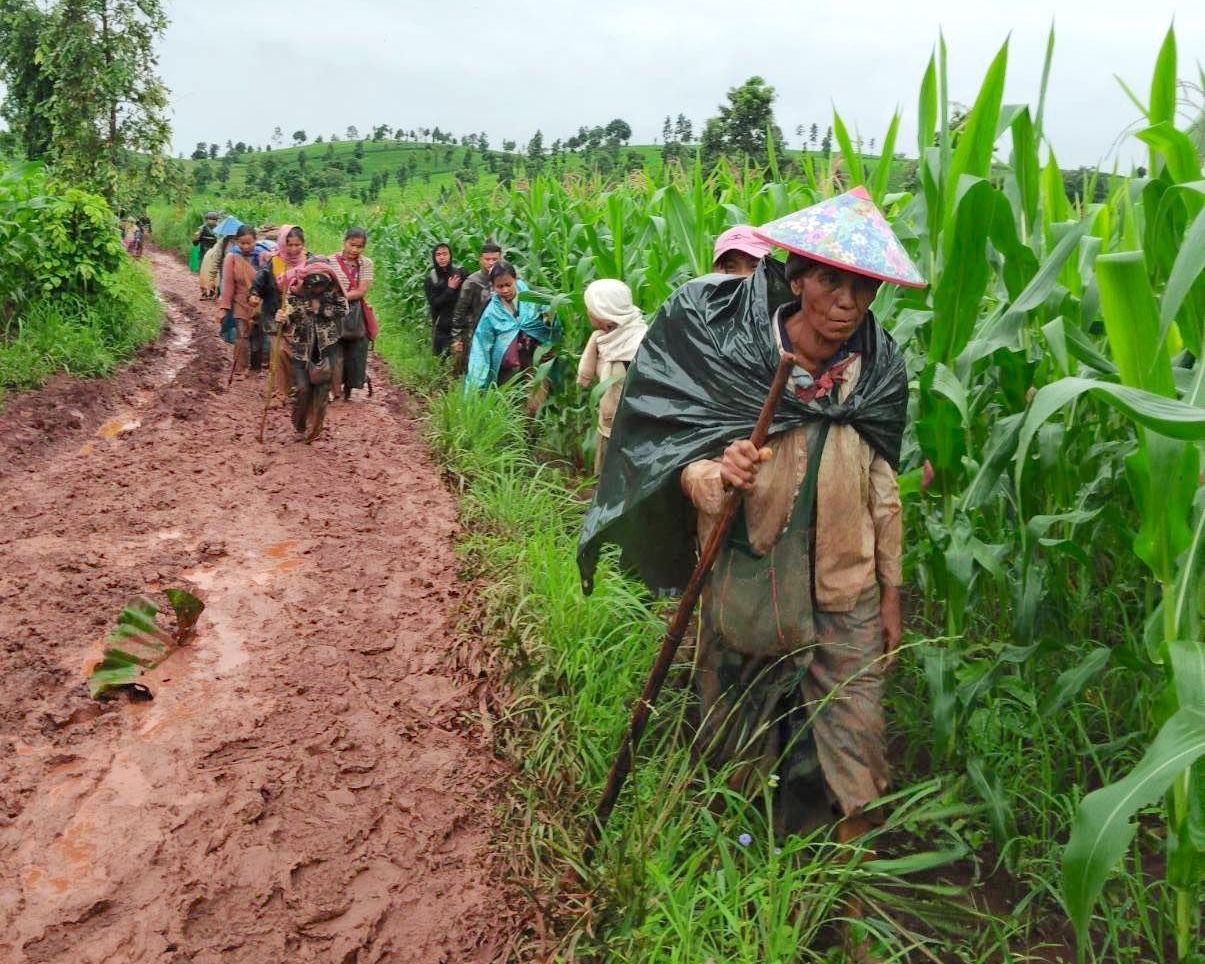|
|
 |
August 7, 2025 |
|
|
|
 |
Rangers help evacuate villagers displaced by Burma Army attacks. |
Thousands Displaced by Burma Army and Flooding |
|
|
Villagers and IDPs face escalating danger from both natural disasters and Burma Army attacks. Flooding in Mone and Ler Doh townships submerged entire villages and destroyed IDP shelters, leaving many—especially children—sick and in urgent need of food, shelter, and medical care. Rangers used boats to deliver aid and medical treatment. Meanwhile, fighting intensified across Kaw T’ree Township, where drones and airstrikes injured and killed resistance fighters, and cluster bombs damaged civilian infrastructure in Kwee Ler Shu Village. From mid-July to early August, Rangers supported evacuations of over 3,400 people from conflict zones in Karenni State and southern Shan State, at times under direct threat of artillery fire. They also provided medical aid, shelter, and food to displaced communities. |
|
|
|
|
|
Left: Flooding reaches roofs in IDP camps. Right: Rangers provide medical treatment to wounded resistance soldiers after a Burma Army bombing. |
Top: Flooding reaches roofs in IDP camps. Bottom: Rangers provide medical treatment to wounded resistance soldiers after a Burma Army bombing. |
|
|
In northern Karen State, rising flood levels destroy IDP shelters while Burma Army drops bomb into village, killing two soldiers.
On Aug. 1, the Burma Army fired a mortar into Nyaung Dah Village, Ler Doh Township (Kler Lwee Htoo District, Karen State), killing two Peoples Defence Force (PDF) resistance soldiers and injuring four. Rangers provided medical aid to the wounded.
Throughout Mone and Ler Doh townships (Kler Lwee Htoo District, Karen State), heavy rain has submerged villages under water and destroyed many IDP shelters as water levels rose to rooftop levels. Many people face urgent needs such as food, shelter, and medical care, specifically children who have become sick from the flooding. Rangers used boats to travel into villages throughout the district to provide medical care and aid where they could. |
|
|
|
|
|
Left: Ranger medic treats villager suffering from malaria. Right: Recently displaced villager recovering belongings from flooded house. |
Top: Ranger medic treats villager suffering from malaria. Bottom: Recently displaced villager recovering belongings from flooded house. |
|
|
In Dooplaya District, Burma military and resistance forces fought over a strategic hilltop in the vicinity of Wallay Town and Rangers treated eight patients and provided tarps to IDPs in nine villages.
On May 28, the Burma military bombed Kwee Ler Shu Village, Kaw T’ree Township, with a cluster bomb that dispersed 18 bomblets, injuring four villagers, damaging a religious building, student dormitory, and several houses, and leaving two unexploded bomblets in the village.
Just a month later, on July 22, in the same village of Kwee Ler Shu, a mountain stream flooded the village damaging houses, maize fields, and roads, displacing those living near the stream. Rangers documented the airstrike and flooding. Rangers also treated four villagers in Maw Hta Village, Kaw T’ree Township who suffered from malaria and inflammatory bowel disease.
On July 26 and 29, Rangers delivered tarps to IDPs residing in the villages of Kyat Chan, Kyauk Ta Kar, Win Ka Na, Pann Aung, Kyauk Be Lu, Khalal Saw, Tanyin, Upper Phaya, and Lower Phaya, in Waw Ray Township of Dooplaya District.
Between July 30 and Aug. 3, Burma military and resistance forces fought over the Waw Lay strategic hill in the vicinity of Wallay City, Kaw T’ree Township. Resistance forces surrounded the Burma Army on the hilltop and Burma military air assets supported their ground forces with a Y-12 supply airdrop, a jet fighter airstrike, and drone strike consisting of two kamikaze drones. Rangers responded to the fighting, treating four wounded resistance soldiers and transporting them to hospital for further treatment. |
|
|
|
On Aug. 1, in Tanintharyi Township during a battle between the Karen National Liberation Army (KNLA) and the Burma Army, one Karen soldier was injured from a drone dropping 120mm mortars. Later, on Aug. 3, two Karen soldiers were killed by 120mm mortars, one dropped from a drone and the other fired at them during a battle. |
|
|
|
|
|
Left: IDP children eat chicken porridge given to them by Rangers after a GLC program. Right: Food and tarps donated at Elephant IDP camp. |
Top: IDP children eat chicken porridge given to them by Rangers after a GLC program. Bottom: Food and tarps donated at Elephant IDP camp. |
|
|
From July 25 to 27, as Burma Army troops advanced from Loikaw to White Pagoda Village in Demoso Township, Loikaw District, Rangers, along with other organizations, evacuated 650 IDPs and villagers from Nan San Khan Village, Aung Thar Yar Village, Lee Woe Village, Elephant Mountain Village, and Pawn River. On July 28, Rangers supported 200 IDPs from East Phekhon Township by providing 20 tarpaulins, food, and hygiene kits at Elephant IDP camp. Rangers also organized a mobile medical clinic and a GLC program on Aug. 3-5 in Do Mo Saw Village for 150 villagers, providing medical treatment to 60 patients while 53 villagers participated in the GLC program. After the event, Rangers distributed chicken porridge to the participants and school bags to the teachers. |
|
|
|
|
|
Evacuating villagers from East Phekhon. |
|
|
Rangers and Karenni National Defense Force (KNDF) successfully evacuated more than 2,750 civilians from 10 villages that were under fire from Burma Army attacks.
Between July 18 and 24, Rangers and KNDF evacuated more than 2,550 internally displaced persons (IDPs), villagers, and resistance fighters from Naung Hlaing, Lal Htun, Daw Paw Kue, Wan Khone, Thar Yu, Khut Law, and Nan Nout villages in East Phekhon Township. On July 27, Rangers carried out another evacuation, relocating 200 IDPs from Si Mi Lot and Khone That Villages in Moebye Township to an undisclosed area. On Aug. 1, Burma Army forced villagers and IDPs hiding in the mountains near White Elephant Village to return to their homes ahead of the upcoming election, threatening them and declaring their presence in the area illegal. The next day, Rangers helped evacuate those threatened, as well as villagers from Lal Htun and A Paw Kone, totalling 500 people. During the operation, Burma Army artillery targeted the evacuation route. The majority of those evacuated were elderly individuals, children, and new mothers. |
|
|
|
|
